My First Coding Book: Packed with Flaps and Lots More to Help you Code without a Computer!
£7.40
Get with the program! Introduce your child to the wonderful world of coding. Packed with flaps, wheels and sliders, this is the essential guide for children wishing to learn the ins and outs of coding.
Written specifically for Key Stage 1 level, My First Coding Book teaches your child how to understand and use basic algorithms and bug fixes. The eye-catching illustrations and hands-on sliders will not only keep your little ones entertained, but will help to improve their ability to solve maths problems as well!
Computer coding is now a key part of the UK National Curriculum and is taught to children as soon as they begin school. My First Coding Book offers a unique and exciting alternative to dull worksheets and is perfect for teachers, parents or grandparents introducing their children to computing.
Give your child a head start without the need for a computer.
Read more
Additional information
| Publisher | DK Children (6 July 2017) |
|---|---|
| Language | English |
| Board book | 24 pages |
| ISBN-10 | 0241283353 |
| ISBN-13 | 978-0241283356 |
| Reading age | 5 – 7 years |
| Dimensions | 28.3 x 2 x 22.4 cm |

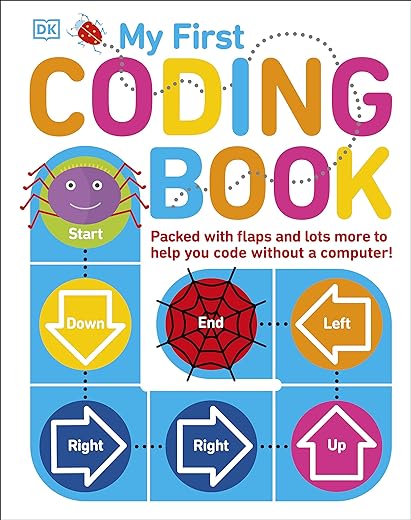
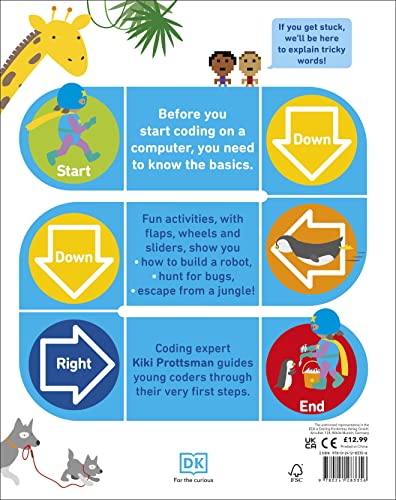


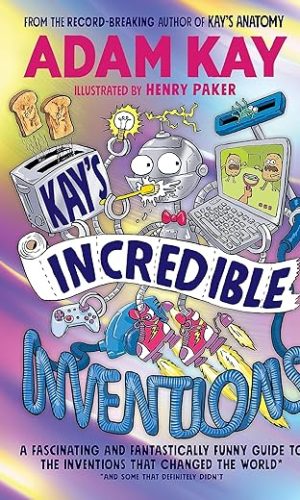

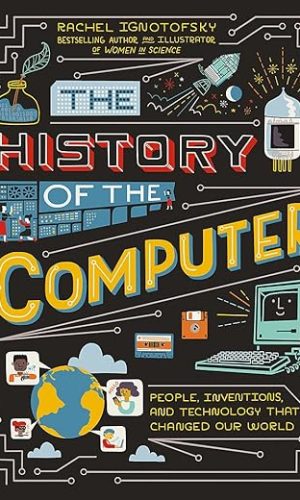
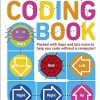
by holly james
This is an excellent science book, fun to look at, fun to do, fun to learn…
by Vitalijs
Good
by Zipster Zeus
Love this book- it’s solid and will take plenty of use and although shortish, power-packed with information and activities to get young coding interests fired up and honed. All the basic concepts are covered in an intuitive, fun way and good in that they can be learnt without using a computer- which gives this book an extra learning dimension, as the concepts it teaches are applicable across a wide range of other learning areas. Excellent.
by kinggx
Coding is not a particularly exciting concept in my opinion but I prefer to think of this as a book about logical thinking and getting under the skin of how things work. Each section explores a different area of logical thinking, like breaking down an activity into its constituent parts (decomposing) and finding out how to make things work without error (debugging). The pages are made from card and feature lift-up and pull-out flaps, providing a degree of interactivity.
From the front cover the book looks like it is targeted at a very young audience but is suitable, in my view, for ages 6+ due to the level of challenge. My daughter is 6 and has enjoyed this, with my help, but was a little put off by the babyish presentation at first.
by Flint lockwood
Good book and nice simple and clear explanations for young kids to learn about the fundamental concepts. It’s not a book that you can go back to day to day just due to it obviously being a static thing, so solving the problems once or twice, kids will then already know the answers.
by S Bruce
My five-year-old daughter lapped this up, going through the whole book in one sitting and then wanting to go back and do it again. In some ways it’s more of a puzzle book than a book about programming, so the appeal was because of the puzzles and games element, but it does raise some of the basic concepts of coding- commands, loops, variables, and so on- in a methodical, step-by-step way. It also has some strong parallels with Scratch and Scratch Jr. software, for example in how loops are represented, which tied in nicely with stuff she’d already tried.
As somebody who knows a bit of coding myself, I was able to expand on some of the ideas and re-explain them in more detail, and answer questions about it, which unfortunately did feel a little bit necessary, because on its own, the explanations were sometimes just a little bit too brief and, in my opinion, jumped on just a bit too quickly. It’s a starting point for a parent-child or teacher-child conversation about ideas behind coding, rather than a book you would just hand to a kid and say “there, read that”.
It gets off to a slightly ropey start with the section about giving instructions to a robot, because the tasks that need to be broken down in a task like “telling a robot how to feed the chickens” are rather arbitrary and my daughter came up with a totally different and equally valid instruction set and then was disappointed when that didn’t match what it said in the book. After a few pages though, tasks like navigating an explorer through a grid without falling into a trap are less subjective and, as a result, more satisfying.
The print quality is good and there are a surprisingly high amount of pull sections and flaps to get stuck in to. My daughter’s only complaint with it was that it was too short, she would’ve happily lapped up twice as many pages, but from a grown-up point of view it’s 4 stars from me because the explanations behind the coding ideas are generally good, but kids may need a bit of grown-up help in order to really get the idea. I also ended up improvising a whole “why coding is useful” monologue at the start, because surprisingly, that fundamental introduction isn’t really present either.
by S. P. Long
This book is an attempt to teach the basics of computer programming to small children. It contains very simple introductions to loops, conditionals and variables, which are indeed the basic building blocks of most programming languages, along with introductions to concepts like debugging, pattern recognition and decomposing a problem into smaller steps. These are all illustrated with bright cartoon-like pictures and various flaps and sliders as in the pop-up books I remember from my childhood.
The good aspect of the book is that the author has indeed made a very sensible selection of programming concepts as a basis for the book, and the explanations are actually pretty good. However, the problem is that it is hard to work out exactly what age he is trying to target with the book – while the appearance, small number of pages and general concept seem to be aimed at perhaps 5-6 year olds, the vocabulary used (terms such as “decomposition”, “conditional”, “persistent” and “variable”) are surely going to be beyond all but the brightest children in that age range. As a result, the potential audience who will both be able to fully understand the book and to not feel patronised by it is probably pretty small.
This is a very honest attempt to introduce programming to very young children, but I can’t help but feel that some more thought about vocabulary used would have made it far better – as it is, it is hard to recommend.
by Amazon Customer
I got this book for my seven year old son, but my wife found it at least as interesting as he does. It covers everything that you need to understand any programming language; conditionals, loops and sequences. There are plenty of apps you can get that cover the same thing, but the tactile nature of this book slows you down enough to actually understand and learn what you are doing. Ideal for anyone who wants to know what coding is.